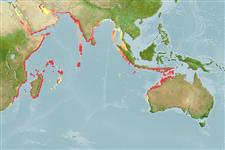>
Eupercaria/misc (Various families in series Eupercaria) >
Labridae (Wrasses) > Corinae
Etymology: Coris: Greek, kore, -es = pupil and also with themenaing of "maid" (Ref. 45335).
Environment: milieu / Klimaatzone / Diepte / distribution range
Ecologie
marien rifbewoner; diepte ? - 20 m (Ref. 9773), usually 2 - 50 m (Ref. 27115). Tropical; 24°C - 27°C (Ref. 27115)
Western Indian Ocean: southern Red Sea to Natal, South Africa and east to Sri Lanka.
Grootte / Gewicht / Leeftijd
Maturiteit: Lm ? range ? - ? cm
Max length : 60.0 cm TL mannelijk / geslacht onbekend; (Ref. 5213)
Dorsale stekels (totaal) : 9; Dorsale zachte stralen (totaal) : 12; Anale stekels: 3; Anale zachte stralen: 12. Terminal males reddish to lavender in color; caudal with small, dark-edged, blue-green spots, posterior margin light orange-red (Ref. 4392). Juveniles orange, head and lower part of body dark brown; 3 large, vertically elongate, broadly black-edged, white spots on dorsal part of body (Ref. 4392).
Body shape (shape guide): fusiform / normal.
Adults found in weed, rock and coral areas; juveniles in shallow tide pools (Ref. 30573). Generally solitary (Ref. 5213). Feeds mainly on hard-shelled prey, including crustaceans, mollusks and sea urchins (Ref. 5374). Young very different (Ref. 1623).
Levenscyclus en paargedrag
Maturiteit | Voortplanting | Paaien | Eieren | Fecunditeit | Larven
Oviparous, with distinct pairing during breeding (Ref. 205).
Randall, J.E., 1999. Revision of the Indo-Pacific labrid fishes of the genus Coris, with descriptions of five new species. Indo-Pac. Fish. (29):74 p. (Ref. 33411)
Status op de Rode Lijst van het IUCN (Ref. 130435: Version 2025-1)
Gevaar voor de mens
Harmless
Gebruik door de mens
Visserij: van minder commercieel belang; Aquarium: Commercieel
Tools
Speciale rapporten
Download XML
Internetbronnen
Estimates based on models
Preferred temperature (Ref.
123201): 24.6 - 28.5, mean 27.1 °C (based on 424 cells).
Fylogenetische diversiteitsindex (Ref.
82804): PD
50 = 0.5000 [Uniqueness, from 0.5 = low to 2.0 = high].
Bayesian length-weight: a=0.00977 (0.00466 - 0.02049), b=3.07 (2.90 - 3.24), in cm total length, based on LWR estimates for this (Sub)family-body shape (Ref.
93245).
Trofisch niveau (Ref.
69278): 3.8 ±0.26 se; based on food items.
Weerstandsvermogen (Ref.
120179): laag, minimale populatieverdubbelingstijd 4,5-14 jaar (Preliminary K or Fecundity.).
Fishing Vulnerability (Ref.
59153): Moderate vulnerability (44 of 100).
🛈
Nutrients (Ref.
124155): Calcium = 28.2 [11.0, 72.2] mg/100g; Iron = 0.512 [0.302, 0.909] mg/100g; Protein = 18.5 [15.7, 20.7] %; Omega3 = 0.115 [0.058, 0.225] g/100g; Selenium = 38.5 [14.9, 105.3] μg/100g; VitaminA = 80.3 [25.7, 271.5] μg/100g; Zinc = 1.78 [0.84, 3.17] mg/100g (wet weight); based on
nutrient studies.
